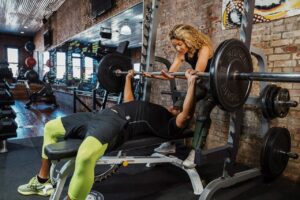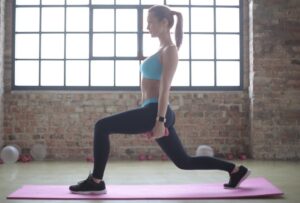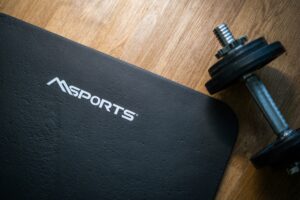There are several ideas for what a well-developed and aesthetic physique should be. Some consider the Mr. Olympia contenders as examples of perfect physical development, whereas others prefer a leaner and more athletic look. But what about people looking for something in the middle between a hulking beast and a lean fitness model? Here is where we take a look at the Greek God physique.
If you’re interested in developing a muscular, symmetric, and chiseled body, you’ve come to the right place. Our guide will teach you everything there is to know about building the ideal Greek God physique––from diet and training to symmetry and exercise selection.
Let’s dive in.
What Is a Greek God Physique?
The Greek physique is one we’ve all seen and admired. Greek mythology describes the twelve gods as the true embodiment of tremendous strength and peak physical development.
A prominent example of the Greek God physique comes from Heracles––the god most people know as Hercules. Farnese Hercules (the statue of Hercules) is the perfect image of the muscular, defined, and proportional Greek God body.
Modern examples of the Greek body from the big screen include Gerard Butler (King Leonidas) in 300 and Bradd Pit (Achilles) in Troy.
Let’s now explore the defining characteristics of the Greek God physique:
Low Body Fat Percentage
Being lean enough is necessary for making your muscle groups appear prominent and defined. You can look good at 15 percent body fat because muscle adds shape to your body, but aim for 10 to 12 percent to look your best. Learn how to measure your body fat percentage.
A Good Shoulders to Waist Ratio
We’ll get into the specific numbers below, but a big part of the Greek God physique is having broad shoulders and a narrow waist.
Muscular Legs
A pair of well-developed legs add balance to your physique and help you develop the X-shape: broad shoulders, a narrow waist, and a wide lower body.
Developed Upper Body Musculature
Aside from working your back and shoulders, you must develop your biceps, triceps, forearms, and chest. Doing so will make your physique appear even more prominent and proportional.
Symmetry
The final puzzle piece is achieving good symmetry and not letting any muscle group take over. Symmetry requires a balanced training approach and proper tracking of your progress.
The Greek God Physique Measurements and Proportions
There have been many bodybuilders with incredible physiques in the sport’s history.
A few notable examples include Arnold Schwarzenegger, Sergio Oliva, Franco Columbu, and Dorian Yates.
Few of the countless competitors who have graced the bodybuilding stage have presented a physique like that of Frank Zane. Standing at 5’9” and weighing around 190 lbs, Zane’s body is an excellent example of the Greek God physique.
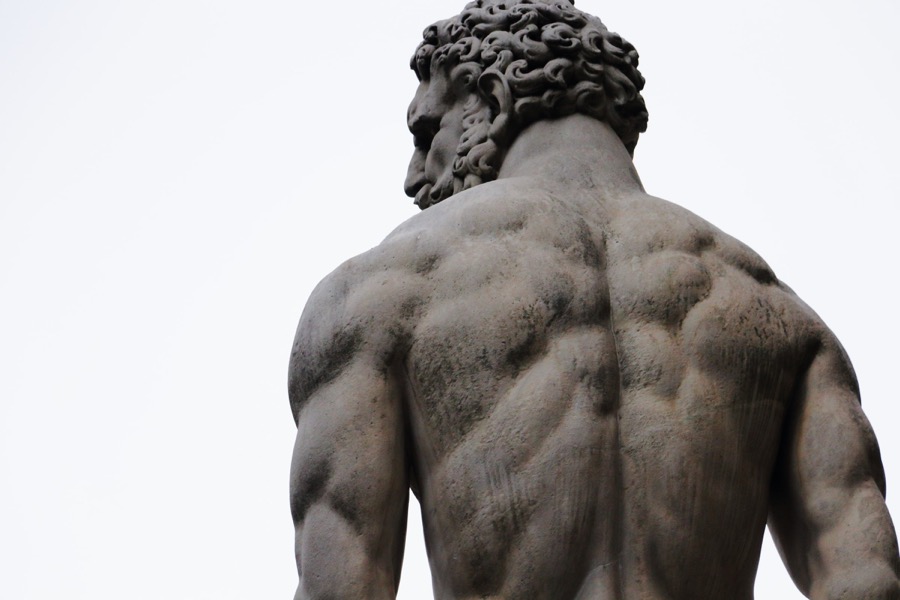
Frank Zane was muscular, but his extraordinary proportions and overall symmetry set him apart from his competition. He wasn’t the tallest or heaviest bodybuilder. Still, his numbers were among the most impressive:
- Chest – 52” (132 cm)
- Arms – 18” (45 cm)
- Waist – 29” (73.7 cm)
- Thighs – 26” (66 cm)
- Calves – 16.5” (42 cm)
How to Determine Your Ideal Greek God Proportions
We are all different, and the ideal proportions vary from person to person. Luckily, you can follow some simple rules to determine what measurements you should aim for to develop a Greek God physique.
The Golden Ratio
It all starts with what bodybuilders call the golden ratio, which refers to a person’s aesthetics based on their shoulder and waist measurements.
The perfect shoulder-to-waist ratio is 1:1.618. To understand your ideal measurements, multiply your waist measurement by 1.618:
| Waist circumference (inches) | Shoulder circumference (inches) |
| 27 | 43.6 |
| 30 | 48.5 |
| 33 | 53.3 |
For instance, if you have a naturally wider waist, you would have to work on your upper body extra hard to achieve the golden ratio.
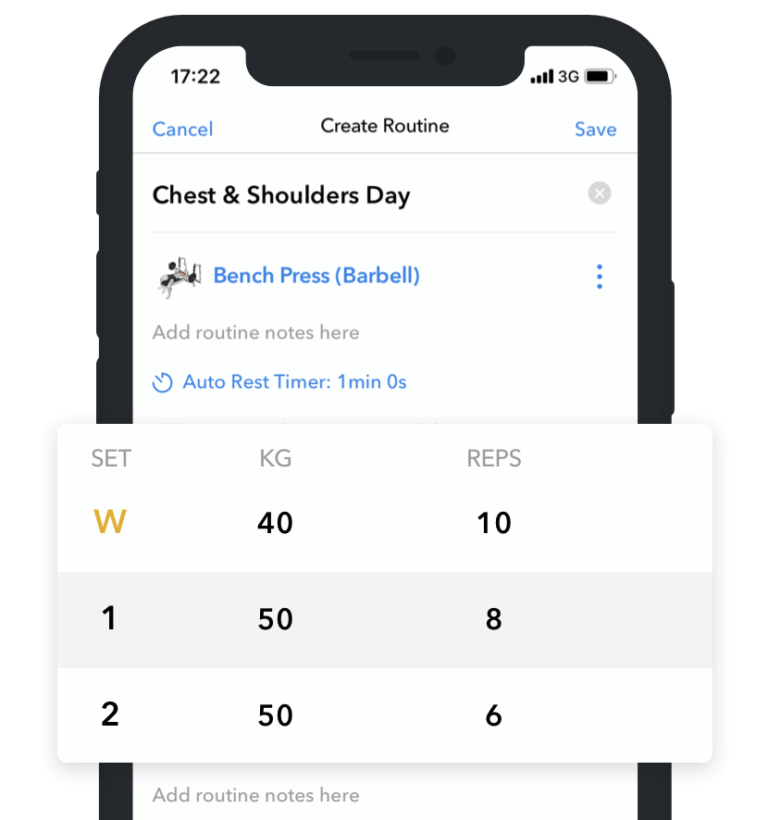
Hevy – Workout Tracker







Hevy – Workout Tracker
Create your own Greek God physique workout with Hevy, and track your progress – for free
Sandow’s Grecian Ideal
Having a pronounced V-taper back is an excellent step in the right direction, but it is far from the only thing you need for a Greek God physique.
As mentioned above, one of the crucial requirements for a Greek God body is having good muscular development. Aside from broadening your back and dieting down for a trim waist, you must add mass to your shoulders, arms, and legs.
Eugen Sandow, the father of modern bodybuilding, created the Grecian Ideal––a blueprint on the ideal proportions for an aesthetic physique. He came up with the numbers by measuring the ratios of statues at various museums.
Soon after starting his experimentation on symmetry, Sandow found a pattern and realized that the perfect proportions come down to simple math. To determine your ideal proportions (in a flexed state), you must make the following circumference calculations based on the Grecian Ideal:
- Upper arms – 2.5 times wrist circumference
- Shoulders – 1.618 times waist circumference (the Golden ratio)
- Chest – 6.5 times wrist circumference
- Thighs – 1.75 times knee circumference
- Calves – equal to upper arm circumference
Let’s take an average person with 6.5” wrists (16.5 cm), 12.5” knees (31.76 cm), and a 32” (81.2 cm) waist. His ideal proportions would be:
- Upper arms – 16.25” (41.275 cm)
- Shoulders – 51.7” (131.3 cm)
- Chest – 42.25” (107.3 cm)
- Thighs – 21.8” (55.3 cm)
- Calves – 16.25” (41.275 cm)
The Right Body Fat Percentage for the Greek God Physique
The final piece of the Greek God physique puzzle is your body fat percentage. Looking like a Greek God requires good muscular development, but you must also be lean enough to reveal your hard-earned muscles and appear more prominent.
A good rule of thumb is to aim for a low body fat percentage of 8 to 10, but there is one problem. That leanness level is unsustainable for most people who feel deprived and food-obsessed (1).
You can get that lean, but don’t expect to maintain the conditioning for too long. A better approach would be aiming for a slightly higher body fat of about 12 percent. You’re less likely to experience the adverse effects of dieting, you will be able to maintain the results with greater ease, and you will feel better throughout the day.
Research finds that excessive dieting increases the risk of muscle loss, hinders testosterone production, flattens sexual drive, and can lead to a poor relationship with food (2, 3, 4).
Who Should Do the Greek God Physique Workout Program?
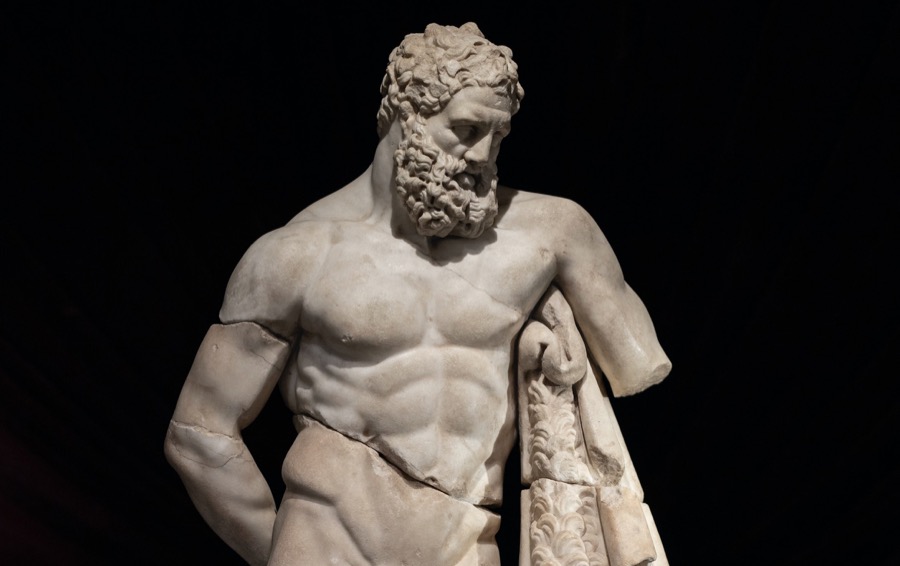

Attaining an aesthetic Greek God physique is no easy task. Here are a few reasons you might want to pursue such a workout plan:
Build a Lean and Proportional Physique
The most apparent reason you might consider a Greek God workout plan is to build a symmetrical and balanced physique by focusing on aesthetics.
Enjoy a Solid and Engaging Training Plan
The beauty of any Greek God physique workout plan is the attention to detail. You’re not simply doing a bunch of compound lifts; instead, you’re sculpting a body, much like an artist carves beauty out of clay or marble.
If you enjoy the details and are dedicated to building a beautiful physique, the Greek God training principles will present a new and exciting approach to working out and eating.
Develop Strength and Functionality
Greek Gods have beautiful bodies and tremendous physical strength. So, what good would a Greek God physique workout be if it didn’t develop any strength?
Our Greek God physique training plan features heavy barbell lifts designed to promote muscle growth and get you stronger. You can also run strength blocks where these core lifts make up most of your training, and you must train with weights close to your one-repetition maximum (1RM).
Pursue Specific Aesthetics Goals
Another fascinating thing about training for a Greek God body is having specific goals for aesthetics. The Golden Ratio and Grecian Ideal provide calculations you can make right now to come up with goals for individual body parts.
Having specific objectives is a great way to stay motivated and see how close you are to achieving your dream physique. For example, if you have 6.5” wrists, you know that you must grow your arms to 16.25”.
The Key Exercises to Focus on for a Greek God Physique (and Why)
Back
We begin the list with the back complex because broadening the area will go a long way in helping you achieve the Golden ratio: waist circumference x 1.618.
The back is an area that consists of numerous muscle groups, including the latissimus dorsi––the largest muscle in the upper body (5).
We recommend training your back with three types of exercises: horizontal pulls, vertical pulls, and hip hinges. Doing so will provide a varied stimulus and allow you to develop the width and thickness necessary for a Greek God physique.
- Horizontal pulls – Inverted Row, Bent Over Row (Barbell), T-Bar Row, Dumbbell Row, Seated Cable Row, Chest Supported Incline Row (Dumbbell), etc.
- Vertical pulls – Lat Pulldown (Cable), Pull Up, Chin Up, Single Arm Lat Pulldown, Shrug (Dumbbell, Barbell), etc.
- Hip hinge – Deadlift (Barbell), Sumo Deadlift, Reverse Hyperextension, Hip Thrust, Glute Bridge, Rack Pull, etc.
Related article: Barbell Back Workouts for a Strong and Muscular Back
Shoulders
Like the back musculature, your shoulders (deltoids) play a crucial role in achieving the Golden ratio. The more developed your shoulders are, the more prominent your upper body will appear, making your waist look smaller.
Your shoulders benefit from the right combination of exercises that train the area from several angles.
The deltoid has three heads: the front (anterior), middle (lateral), and rear (posterior) (6). Training each head is necessary for achieving the round and prominent shoulder look.
- Front deltoid head – Front Raise (Cable, Dumbbell, Plate), Seated Shoulder Press (Dumbbell), Overhead Press (Barbell), etc.
- Middle head – Overhead Press (Barbell), Lateral Raises (Dumbbell), Upright Row (Barbell), etc.
- Rear delts – Face Pull, Reverse Fly (Dumbbell), etc.
Related article: Two Unique Shoulder Dumbbell Workouts to Develop Both Mass and Strength
Chest
Building a broad and thick chest is crucial for the Greek God physique. The muscle group makes your entire upper body appear more prominent from any angle.
The chest musculature is essential for various athletic activities and plays a role during gym exercises like overhead presses, dips, and more (7).
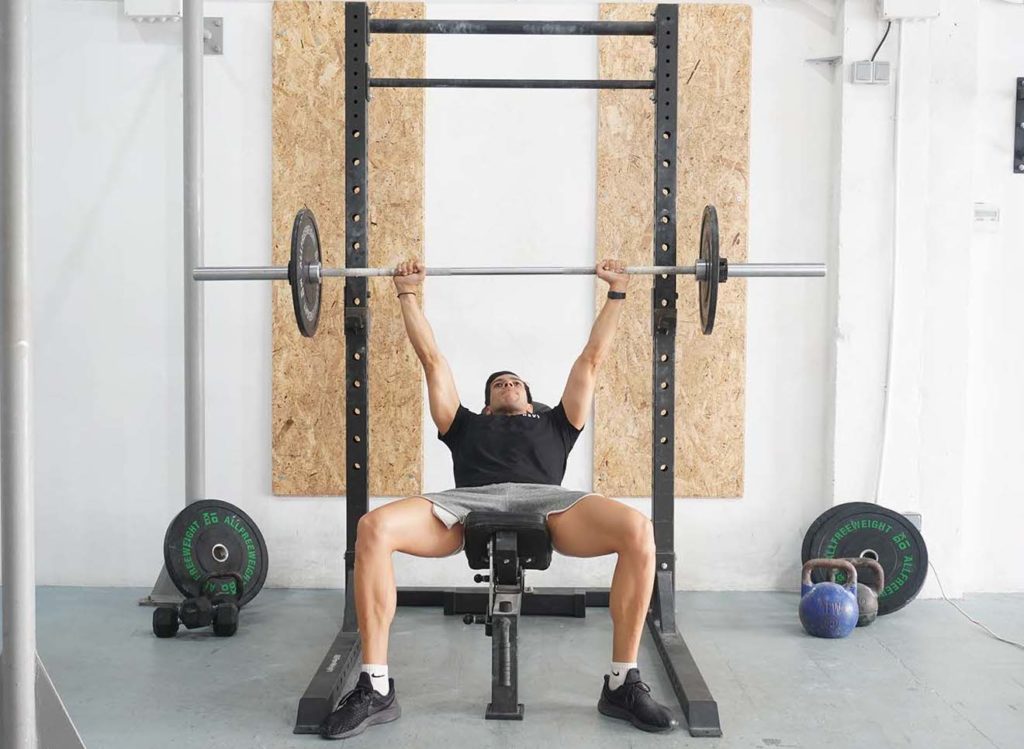

Optimal development requires training the muscle from at least two angles. Doing so allows you to emphasize the pecs’ upper (clavicular) and middle (sternocostal) heads.
- Upper chest – Incline Bench Press (Dumbbell, Barbell), Incline Chest Fly (Dumbbell), Decline Push Up, Low Cable Fly Crossover, etc.
- Mid and lower chest – Bench Press (Barbell, Dumbbell), Butterfly (Pec Deck), Cable Fly Crossover, Chest Dip, etc.
Biceps
The biceps make up the front portion of your upper arms and contribute to aesthetics. Having a broad back, defined midsection, and bulging shoulders is fantastic, but you will limit your physique by failing to develop a pair of muscular arms.
Your bicep has two heads: a short (inner) and a long (outer) head (8). Developing both heads evenly is necessary for making your biceps appear wider, thicker, and taller.
Training your biceps with various movements is also helpful for developing the brachialis––a muscle that lies underneath the bicep, pushing it up when it grows.
- Short bicep head – Wide Grip Curl (Barbell), Concentration Curl, Spider Curl (Barbell), Chin Up, etc.
- Long bicep head – Drag Curl, Narrow Grip Curl (Barbell), Reverse Curl, Seated Incline Curl (Dumbbell), Hammer Curl (Dumbbell), Rope Cable Curl, etc.
Related article: 2 Effective Dumbbell Bicep Workouts to get Large Muscular Arms
Triceps
Just as you need to develop the front portion of your upper arms, you must build your triceps to create balance and symmetry.
The tricep is a three-headed muscle primarily responsible for elbow extension (straightening your arms) (9). Like the bicep, it benefits from good exercise selection and adequate emphasis on all three heads.
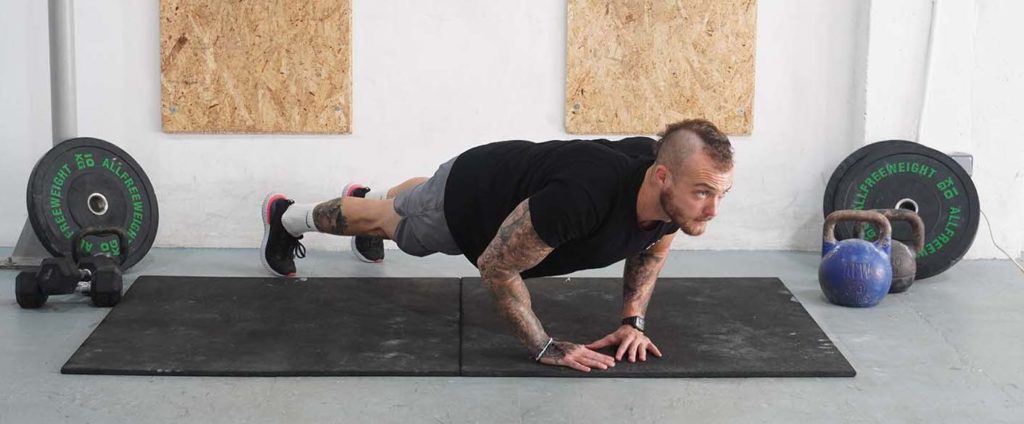

Here are some great movements to consider:
- Diamond Push Up
- Triceps Rope Pushdown
- Tricep Kickback
- Bench Press – Close Grip (Barbell)
- Triceps Dips, Bench Dip
- Triceps Extension (Dumbbell)
- Skullcrusher (Barbell, Dumbbell)
- Seated Dip Machine
Related article: Killer Chest and Tricep Workout to Obtain Large Sculpted Muscles
Forearms
Direct forearm training is not mandatory but recommended. Just as your legs benefit from a pair of meaty calves, your arms appear more muscular when you develop the forearms.
Doing various movements for your biceps will indirectly train your forearms. Additionally, we recommend a few simple activities:
- Dead Hang
- Farmers Walk
- Seated Palms Up Wrist Curl
- Wrist Roller
Hamstrings
The hamstrings are the muscle group that makes up the posterior of your thighs. Its primary functions are knee flexion (bending the leg) and hip extension (along with the glutes) (10).
Most people focus entirely on the quadricep, but developing the hamstrings creates balance in the upper legs and leads to excellent muscle growth.
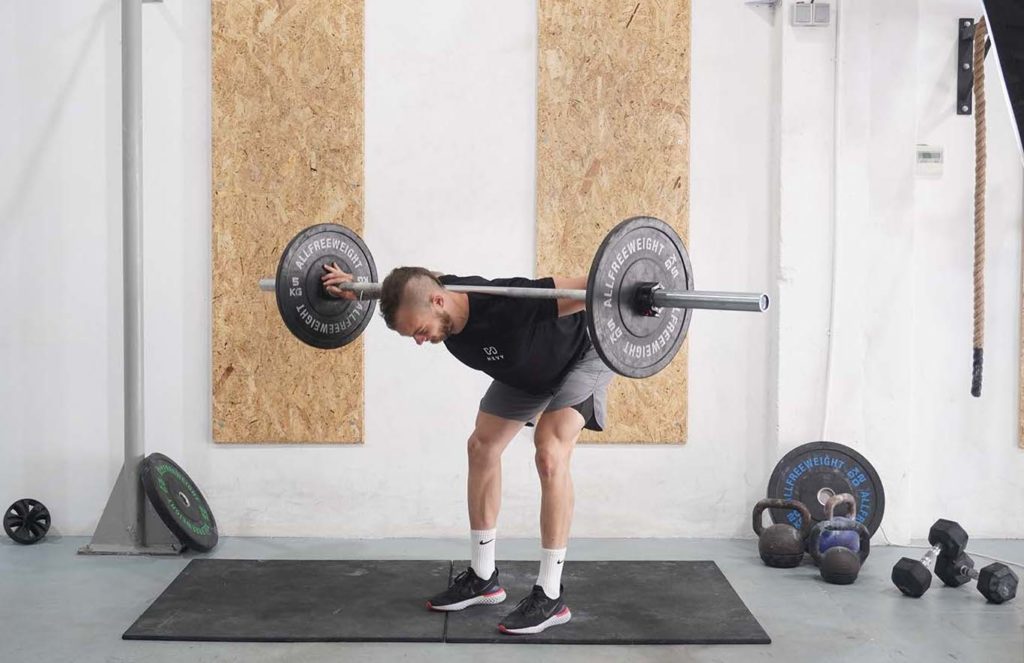

Including knee flexion and hip extension exercises in your training is beneficial for optimal hamstring growth.
- Knee flexion: Glute Ham Raise, Lying Leg Curl (Machine), Seated Leg Curl (Machine), etc.
- Hip extension: Deadlift (Barbell), Romanian Deadlift (Dumbbell, Barbell), Good Morning (Barbell), etc.
Related article: The Top Dumbbell Leg Workouts to Attain Powerful Legs
Quadriceps
The quadriceps is one of the largest muscles in the body and makes up the front portion of your thighs. Developing the four-headed muscle makes your legs appear much more prominent and contributes to overall symmetry.
Your quads are primarily responsible for knee extension (straightening of the legs), and training them isn’t that complex (11). Still, we recommend doing at least two to three movements to ensure optimal development:
- Squat (Barbell)
- Bulgarian Split Squat
- Front Squat
- Goblet Squat
- Leg Extension (Machine)
- Leg Press (Machine)
- Lunge (Dumbbell)
Glutes
The gluteus maximus is the largest muscle in your body (12). Its primary function is hip extension, but it also plays essential roles in walking, running, jumping, and more.
Doing direct work for your glutes is beneficial for making your lower body appear even more prominent and proportional. The muscle group is also crucial for whole-body strength, stability, and athleticism.
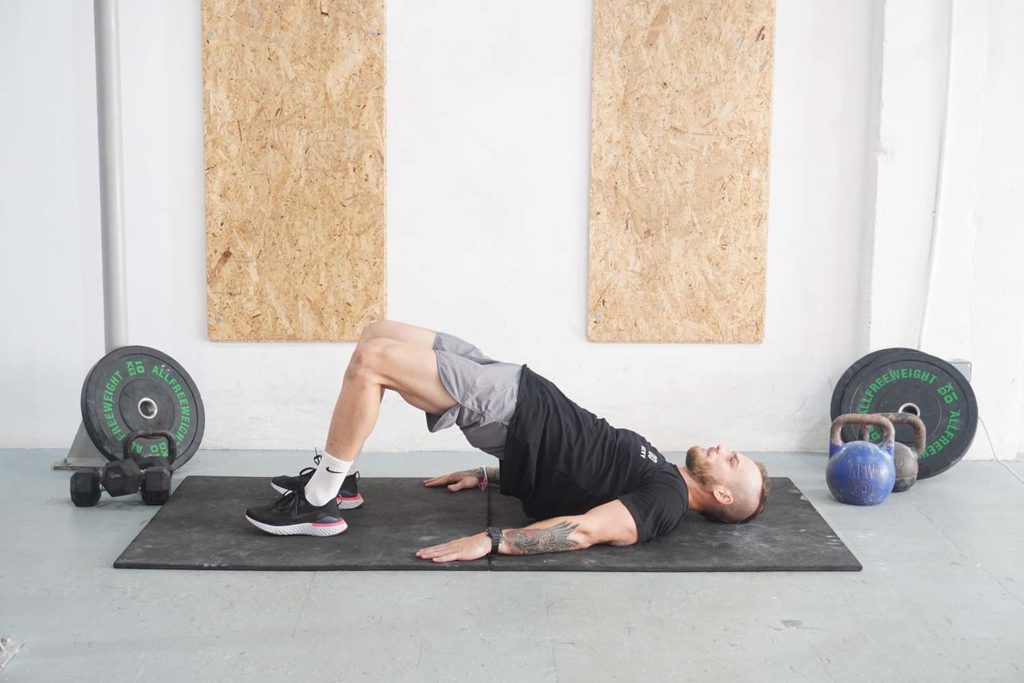

Here are some fantastic movements to consider:
- Hip Thrust (Barbell)
- Glute Kickback (Machine)
- Glute Bridge
- Glute Ham Raise
- Cable Pull Through
Related: Top 15 Gluteus Minimus Activation Exercises
Calves
As mentioned earlier, your calves provide lower body symmetry, making your thighs appear more aesthetic. Well-developed quads will always look great, but we can all agree that having sticks for lower legs will diminish their appearance, at least to some degree.
Just as you should do some direct work for your forearms, making an effort to train your calves will pay dividends and contribute to a beautiful Greek God body.
You should ideally perform standing and seated calf raises to evenly train both calf muscles (the gastrocnemius and soleus). Here are a few movements to consider:
- Calf Press (Machine)
- Standing Calf Raise (Machine)
- Seated Calf Raise
- Single Leg Standing Calf Raise (Dumbbell)
A Complete 8-Week Workout Routine for a Greek God Physique
Now that we’ve laid the groundwork and have specific aesthetic goals, it’s time to go over how to build a Greek God physique.
The following is a 4-day upper/lower program based on linear progression (similar to a 5×5 program). Note that we’ve put together the split to work for the average person. Your unique training needs might differ, so it is best to tweak some variables (e.g., exercise selection, number of sets, rep ranges, rest periods, etc.) to find what works best for you.
The following points will discuss some actionable ways to change the workout program.
Day 1 (Upper A)
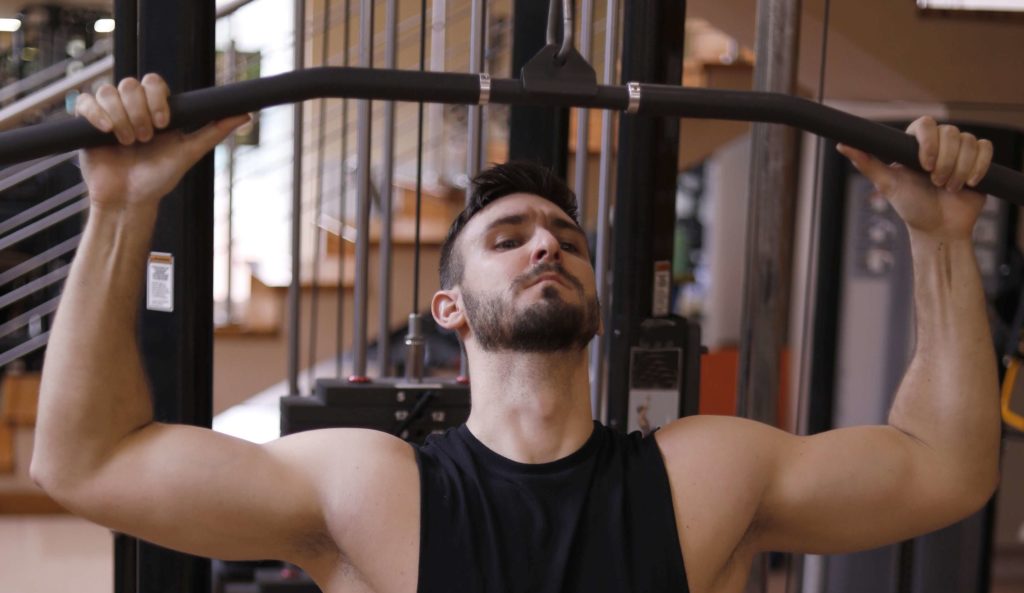

| Type | Exercise | Sets | Reps | Rest Period |
| Set | Bench Press (Barbell) | 3-4 | 5-8 | 2-4 minutes |
| Set | Bent Over Row (Barbell) | 3-4 | 5-8 | 2-3 minutes |
| Set | Shoulder Press (Dumbbell) | 3 | 8-12 | 1.5-2 minutes |
| Set | Lat Pulldown (Cable) | 3 | 10-12 | 1.5-2 minutes |
| Superset 1 | Tricep Rope Pushdown | 2-3 | 12-15 | |
| Bicep Curl (Cable) | 2-3 | 15-25 | 1.5 minutes | |
| Set | Seated Palms Up Wrist Curl | 2-3 | 15-25 | 1-1.5 minutes |
The combination of exercises works great for balanced muscle development. But, as mentioned above, you can tweak each session to fit your needs.
For instance, if you don’t enjoy the barbell bench press, you can perform the movement with dumbbells. Similarly, if you don’t have access to a cable machine, you can do dumbbell kickbacks and curls instead of pushdowns and cable curls.
On the superset, you must perform the two exercises back-to-back with almost no rest. For instance, do a set of pushdowns, perform a set of curls, and take a break. Supersets are a helpful tool for doing more work in less time to finish quicker.
Day 2 (Lower A)
| Type | Exercise | Sets | Reps | Rest Period |
| Set | Squat (Barbell) | 4 | 5-8 | 2-4 minutes |
| Set | Romanian Deadlift (Dumbbell) | 4 | 10-12 | 2-2.5 minutes |
| Set | Bulgarian Split Squat | 3 | 10-12/per leg | 1.5-2.5 minutes |
| Set | Seated Leg Curl (Machine) | 2-3 | 12-15 | 1.5-2 minutes |
| Superset | Standing Calf Raise (Machine) | 3 | 8-12 | 2 minutes |
| Calf Raise (Machine) | 3 | To failure |
Workout two also features a superset, but the objective is to train the same muscle group. Two back-to-back exercises for the calves will stress the muscle significantly, possibly leading to better growth in that stubborn area.
Day 3 (Upper B)
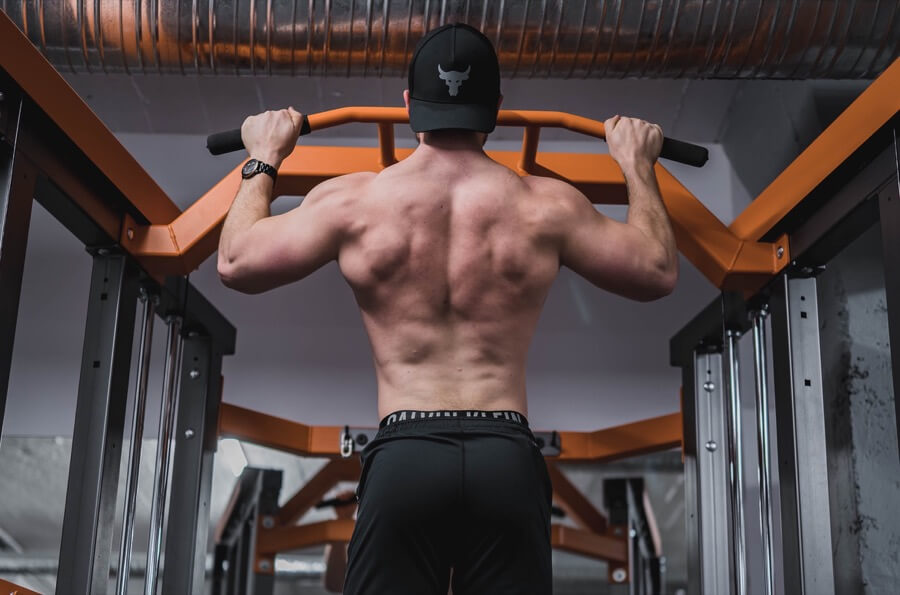

| Type | Exercise | Sets | Reps | Rest Period |
| Set | Pull Up | 4 | 5-15 | 2.5-3 minutes |
| Set | Incline Bench Press (Dumbbell) | 4 | 8-12 | 2-2.5 minutes |
| Set | Dumbbell Row | 3 | 10-12 | 1.5-2.5 minutes |
| Set | Seated Shoulder Press (Machine) | 3 | 10-12 | 1.5-2 minutes |
| Superset | Concentration Curl | 2-3 | 12-15 | |
| Seated Dip (Machine) | 2-3 | 12-15 | 1.5-2 minutes | |
| Superset | Cable Fly Crossover | 3 | 15-20 | |
| Face Pull | 3 | 15-25 | 1-1.5 minutes |
The third workout of the week features two supersets. We’ve included these to bump the intensity near the end and save you some time.
As with the other workouts, you can make some exercise swaps and adjust the variables if you find that something doesn’t work. For instance, if you cannot do pull-ups, do the slightly easier chin-ups or assisted pull-ups (on a machine).
Similarly, if your gym doesn’t have a seated dip machine, you can do kickbacks, rope extensions, overhead extensions, or diamond push-ups.
Day 4 (Lower B)
| Type | Exercise | Sets | Reps | Rest Period |
| Set | Hip Thrust (Barbell) | 4 | 5-10 | 3-4 minutes |
| Set | Front Squat | 3 | 8-10 | 2-3 minutes |
| Set | Glute Ham Raise | 3 | 8-15 | 2-3 minutes |
| Set | Leg Extension (Machine) | 2-3 | 12-15 | 1.5-2 minutes |
| Set | Glute Kickback (Machine) | 2-3 | 15-20/per side | 1.5-2 minutes |
| Set | Single Leg Standing Calf Raise (Dumbbell) | 3 | 15-20/per side | 1-1.5 minutes |
The final workout of the week doesn’t have supersets. Unlike the previous lower session, Lower B is more focused on the posterior chain––glutes, hamstrings, and lower back.
Sample Greek God Physique Progression Over 8 Weeks
As discussed above, the Greek God physique workout uses linear progression, so let’s break down what it means.
The objective is to promote overload by doing more work over time. Doing so is necessary for stimulating your muscles adequately and promoting growth. Linear progression means covering specific repetition goals before increasing the load.
For example, the above program calls for sets of 5 to 10 reps on the hip thrust. You should pick a load you can handle within that range and gradually work to 4 sets of 10 reps before increasing the load.
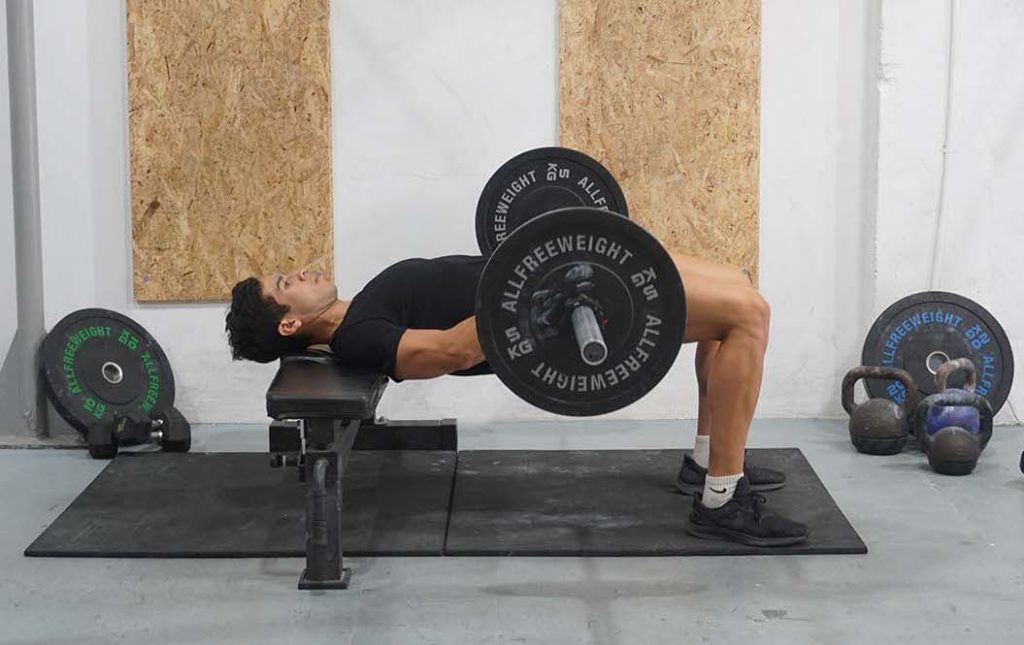

Example of Linear Progression For 8 Weeks on Hip Thrusts
| Week | Load | Reps | Decision | Volume-Load |
| 1 | 165 lbs | 10, 10, 10, 10 | Increase | 6600 lbs |
| 2 | 170 lbs | 10, 10, 9, 8 | Maintain | 6290 lbs |
| 3 | 170 lbs | 10, 10, 10, 10 | Increase | 6800 lbs |
| 4 | 175 lbs | 10, 9, 9, 8 | Maintain | 6300 lbs |
| 5 | 175 lbs | 10, 10, 10, 9 | Maintain | 6825 lbs |
| 6 | 175 lbs | 11, 11, 10, 10 | Increase | 7350 lbs |
| 7 | 180 lbs | 10, 10, 10, 9 | Maintain | 7020 lbs |
| 8 | 180 lbs | 11, 10, 10, 10 | Increase | 7380 lbs |
The rule applies to all other exercises, though we recommend focusing on making progress on the core lifters. You’re much more likely to increase the weight on movements like hip thrusts than dumbbell lateral raises.
Logging your workouts with our app would make it easier to track your progression and make better training decisions on the go. For example, seeing that you covered your repetition goals last week would be an excellent indicator to increase the weight now.
Progression is rarely perfect, and you will most likely have to lift the same weight two, three, four, or more weeks in a row before you’re ready to move up.
It is also important to note that you should only increase the load when you’re confident in your technique. Ego lifting to cover your repetition goals is an excellent way to get injured and not train your muscles as effectively.
Once you finish an 8-week cycle, take a deload or recovery week to give your body a break, and start over. You can swap some of the exercises and change some of your repetition goals for the new cycle. Doing so is a nice way to keep things fresh and engaging.
How to Track Your Greek God Physique Progress (4 Simple Tactics)
Getting a Greek God physique depends on tracking your training and aesthetics progress.
Greek God Physique Workout Progress
As discussed earlier, a good training program needs to provide an overload for you to continue gaining muscle and strength.
Repeating the same thing will only work for a while before you plateau and stop making progress.
To avoid stagnation, you must track your workouts: the exercises, weights, reps, sets, rest periods, etc. Doing so allows you to review your performance over time and see if you’re moving in the right direction.
For example, let’s say that last month you could bench press 135 lbs for five sets of five reps, but you can now do 5×5 with 155 lbs. It means you’ve progressed, and your chest, shoulders, and triceps have likely gotten slightly bigger.
In contrast, you might notice that your numbers haven’t improved in a month or two. That could be the motivation you need to change something about your training or push yourself harder.
Attaining a Greek physique doesn’t mean you have to turn into a powerlifter and train with the heaviest weights possible. It means gradually doing more work than you were capable of before.
If you are looking for a practical way to put together workouts and easily track your performance weekly, check out the Hevy app. Our app makes putting together workouts and reviewing your performance effortless.







Hevy – Workout Tracker







Hevy – Workout Tracker
Create your own Greek God physique workout with Hevy, and track your progress – for free
Visual Appearance
The second aspect of progress tracking for a Greek God body is your visual appearance. Since the training approach focuses on aesthetic improvements, you must take progress photos and compare how your body changes over time.
An excellent way to take progress photos is by standing in front of a light source (e.g., a window), placing your phone or camera on an object, and photographing yourself from three angles: front, side, and back. Take full-size photos and avoid having your phone too close to your body.
You can take additional photos using various bodybuilding poses, but stay consistent with your posing to have comparable images.
It’s also best to take your pictures at regular intervals (e.g., every four weeks) and at the same time of day. Taking pictures on an empty stomach in the morning is ideal because it makes for a more consistent appearance.
Circumference Measurements
The third way to track your progress on your way to a Greek God body is by taking circumference measurements of several key areas in your body. Doing so will provide further insight and help you determine if you’re moving in the right direction.
For example, you’re tracking your body weight (more on that next), and it steadily increases. But circumference measurements suggest that your waist expands far quicker than your arms, chest, or thighs. Such measures could indicate that you’re gaining weight quicker than you should, most of which is fat instead of muscle.
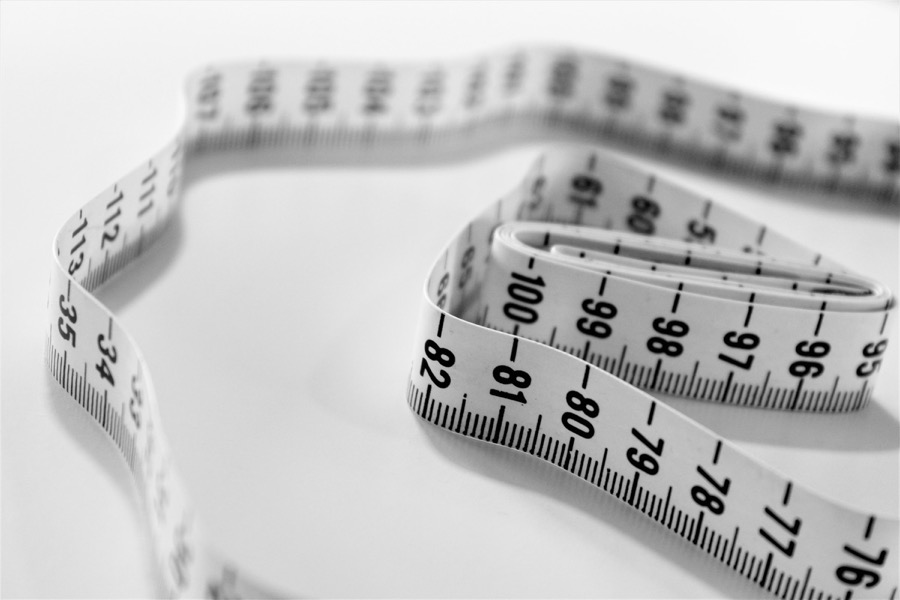

Here are the body parts you should measure:
- Chest (at nipple line or an inch above it)
- Upper arm (flexed bicep, measuring the peak)
- Midsection (an inch above the navel and at the navel)
- Hips
- Thighs (flexed, at the widest point)
- Calves (flexed, at the widest point)
- Forearms (flexed, at the widest point)
Use a tape measure, write down each value to the 0.1 of an inch or cm and take these measurements every four weeks.
Similar to progress photos, it would be best to take these in the morning on an empty stomach for consistency and accurate measurements.
Body Weight
The final way to track your progress is by monitoring your body weight. Regardless of your short-term goal (i.e., to gain muscle or lose fat), body weight is a valuable metric that tells if you’re eating the correct number of calories.
Along with workout progress, photos, and circumference measurements, body weight gives you the data you need to know if you’re doing okay.
The best way to track your body weight is to take multiple weekly weigh-ins, but limit them to once daily. Like progress photos and measurements, the best time to weigh yourself is on an empty stomach in the morning.
Weigh yourself at least four times per week, calculate the average, and compare, looking for a trend. For example:
Monday: 187.4 lbs
Tuesday: N/A
Wednesday: 187.8 lbs
Thursday: N/A
Friday: 187.9 lbs
Saturday: 187.7 lbs
Sunday: N/A
Average for the week: 187.7 lbs
Compare the value from week to week. You should gain no more than a couple of lbs per month when bulking and lose between 0.5 and 1 lb when in a calorie deficit and doing a weight loss phase (13).
An Overview of the Nutritional Approach Necessary for a Greek God Physique
Calorie Intake
Paying attention to your calorie intake is necessary for losing and gaining weight when you need to.
Optimal muscle gain requires a slight calorie surplus––consuming more calories than you expend (14). Doing so provides your body with the energy it needs to carry out its processes and store the excess calories in the form of muscle and fat.
In contrast, fat loss requires a calorie deficit––eating fewer calories than you expend (15). The lower calorie intake forces your body to break down fat and muscle for the remaining energy it needs, resulting in weight loss.
You should spend most of your time in a calorie surplus, aiming for steady weight gain. Muscle gain occurs much more slowly than fat loss, and dedicating most of your time to it will help you develop a Greek God physique.
People who worry too much about staying lean struggle to gain muscle and often look the same even after years of hard training. Fat loss should make up no more than a fourth of your time––for every four months of gaining, you can allow yourself a month of fat loss dieting (calorie deficit). You can do a 3-month cutting phase if you spend nine months gaining.
Macronutrient Recommendations
Aside from ensuring an adequate calorie intake, you must pay attention to your macronutrients: carbohydrates, fats, and proteins. Each macronutrient is necessary for good health and optimal gym progress (16).
Here is a good macronutrient split:
- Carbohydrates – 45 to 50 percent of your calories
- Protein – 25 to 30 percent of your calories
- Fats – 20 to 30 percent of your calories
For instance, if your daily calorie intake is 3,000 calories, you would have to get 1350 to 1500 calories from carbs, 750 to 900 calories from protein, and 600 to 900 calories from fats.
To calculate how many grams you should eat of each nutrient, divide the calories by the energetic value per gram of each nutrient. Proteins and carbs provide 4 calories per gram, and a gram of fat is 9 calories.
For example, if you should get 750 to 900 calories from protein, that would equal an intake of 187 to 225 grams daily (750 / 4 or 900 / 4). Similarly, 600 to 900 calories from fats would mean 66 to 100 grams daily (600 / 9 or 900 / 9).
Alternatively, get enough daily calories and do your best to eat a diverse diet consisting of various whole foods: meat, fish, eggs, dairy, fruits, vegetables, grains, etc.
Supplements for a Greek God Body
Supplements are not mandatory for a Greek God physique. Your nutrition, training, and recovery will largely determine your outcomes.
Still, certain products can give you an edge. For example, protein powder is a good supplement because it provides a concentrated dose of the nutrient, making it easy to reach your daily goal.
You can have a scoop or two of protein powder daily and cover some of your needs instead of eating yet another steak, chicken breast, or serving of cottage cheese.
Creatine is another product to consider because it promotes energy production and can positively affect your training performance and recoverability (17).
Monohydrate is the most studied creatine form. The product is affordable and effective; you only have to take three to five grams daily to reap the benefits.
Conclusion
Achieving a Greek God physique is an admirable goal, but it takes dedication, consistency, and attention to detail. Depending on your current fitness level, it could take you a few months or a few years to reach your ideal body.
Though it may not seem so, achieving the perfect body comes down to simple ratios. Making the necessary calculations for yourself will give you actionable goals for every body part. From there, it boils down to following a balanced training plan, paying attention to your nutrition, and recovering well.
Monitoring your progress is also a crucial part of the process. Tracking more metrics (body weight, circumference measurements, visual, etc.) provides the data you need to determine if you’re moving in the right direction.
Gym progress is also essential to track because it tells you if you’re creating the necessary overload to promote muscle growth. In other words, you must do more work as time passes to give your muscle groups a reason to keep developing.
Check out Hevy and start tracking your Greek God physique workouts in two simple steps.







Hevy – Workout Tracker







Hevy – Workout Tracker
Create your own Greek God physique workout with Hevy, and track your progress – for free


